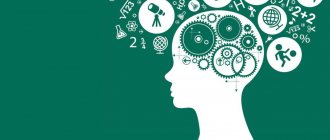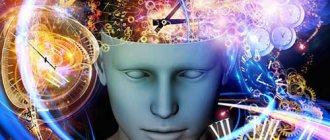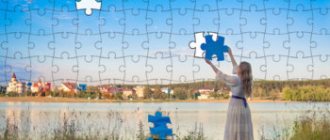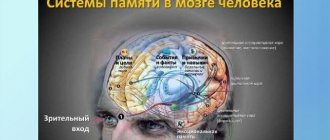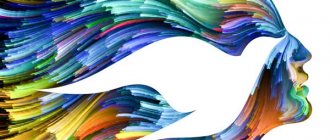The concept of imagination, its types, functions, mechanisms, physiological basis
As a subject of action, a person not only contemplates and cognizes, but also changes the world, transforms nature, creates objects that are not there. But a person could not do all this if he did not imagine the result of his actions. To transform the world in practice, you must be able to transform it mentally, imagining it.
First, a person becomes deeply acquainted with the image of the thing being created, forms his mental image, and then reproduces it when making a similar thing. But when a completely new thing is being made, there is no such rehearsal. Then a new image is created. This ability to create new images is called fantasy.
The process of imagination is manifested in the creation of something new - thoughts and images, on the basis of which new actions and objects are created. This is the creation of something that did not yet exist in reality.
The images with which a person operates include not only perceived processes and phenomena. These can be events, facts, phenomena, witnesses that a person did not have and could not have. Images of the imagination may contain inevitable, desired, possible events and phenomena. And at the same time, something new, created in the imagination, is always connected with what really exists. Images of the imagination are based on memory representations, but are subject to transformation in the imagination. According to R.S. Nemova, imagination is the ability to imagine an absent or unreal object, hold it in consciousness and mentally manipulate it.
Imagination is associated with all aspects of human activity, with memory, perception, thinking. Thus, the perception of works of art becomes more meaningful, more emotional, when it includes imagination. L.S. Vygotsky said: “The creative activity of the imagination directly depends on the richness and diversity of a person’s previous experience, because experience is the material from which the constructions of the imagination arise. The richer a person’s experience, the more material his imagination has.” The connection between imagination and thought is clearly manifested in a problem situation. Faced with the unknown, a person begins to analyze, synthesize, correlate what is perceived with previous experience, trying to penetrate into the essence of the relevant facts and phenomena. In this process, he is helped not only by thinking and memory, but also by imagination, because it creates a complete picture and fills in the missing elements. The process of imagination is peculiar only to man and is a prerequisite for his work activity.
Types of imagination differ in the degree of activity and consciousness with which a person creates new images. Depending on this, a distinction is made between involuntary (passive) and voluntary (active) imagination. In the involuntary imagination, new images are formed under the influence of poorly realized needs, aspirations, and attitudes. Such imagination works when a person is asleep, in a sleepy state, in a thoughtful state, etc.
Voluntary imagination is the process of consciously constructing images in connection with the goal pursued by a particular type of activity. Voluntary (active) imagination arises at an early age; it is most developed in children's play. In role-playing games, children take on different roles; during the game, active imagination is required, since it is necessary to correctly structure their behavior in accordance with the role taken on. In addition, you need to imagine the missing objects and the action of the game.
Free imagination is divided into recreated and creative. Restorative imagination is characterized by the fact that in its process new images are subjectively formed, which are new to a person, but objectively they already exist, embodied in certain cultural objects. The essence of the reconstructed imagination is that a person reproduces, reproduces what he did not perceive, but what other people convey to him through language, drawings, diagrams, signs, and so on.
There must be a connection between images and ordinary symbols, as well as decoding signals, symbols and signs.
Thus, reconstructive imagination is the creation of a new image based on verbal descriptions, the perception of images in the form of pictures, diagrams, maps, drawings, mental and material models.
Creative imagination plays an important role in human life. It allows you to exchange experiences, helps each person to master the experiences and achievements of other people.
The Essence of Imagination
What is imagination
Every image reproduced by a person is the embodiment of a modified reality.
Imagination is the process of creating new images by transforming ideas obtained in the surrounding reality.
When a person creates something new, he has in his mind an image that does not exist in reality, built thanks to his experience.
Imagination is closely related to memory, thinking and perception. Thanks to the connection between thinking and imagination, it is possible to get out of difficult life situations and solve problems with uncertain conditions.
If it is necessary to reproduce situations from past experience, then a person finds in his memory certain images that he had previously stored.
The perception of life would not be so bright and emotional without the participation of imagination. Throughout human evolution, the process of creating images has been involved not only in the development of work, but also in dreams and plans.
Stages of imagination development in ontogenesis
The ability to imagine is not given at birth. Imagination develops with the accumulation of practical experience, the acquisition of knowledge, and the improvement of all mental functions. In modern psychology.
There is a large number of studies devoted to the development of imagination in ontogenesis. Basically, the age periods of development and the type of activity in which it developed were studied. There are the following stages of imagination development:
The first stage (from 0 to 3 years) - the prerequisites for imagination are ideas that appear in the second year of life. A child aged about one and a half years recognizes the image. It is her imagination that helps her recognize the picture. She constructs something that does not quite fit into the memory of the representation. By recognizing, the child does not create anything new. Therefore, imagination is a passive process. It exists within the framework of other mental processes, and its basis is laid in them. The child's ability to act in an imaginary situation with imaginary objects indicates the first manifestations of imagination. The first imitation games that appear in the second year of life do not yet contain elements of imagination. One of the reasons for the emergence of fantasy is the psychological distance between the child and the adult, the child and the object of his desire. The child perceives the basic actions of an adult, but reflects them in a generalized and conditional manner, conveying only their meaning and external design.
The development of the first forms of imagination in early childhood is associated with the generalization of play actions and play objects, as well as
The repertoire of game actions firmly includes substitutions.
According to V.A. Skorobogatova and L.I. Konovalova, the baby does not immediately respond to the replacements offered by adults, but plays only with real toys. The turning point comes when the child refuses to use any substitute offered by adults. The most important factor ensuring the possibility of transmitting meaning to other objects is the emergence of linguistic forms. Mastering the language leads to the appearance of the first independent substitutions in the game. There's a new way to work with replacement objects—using replacements entirely. Selecting Replacement Objects
substitutes comes into consciousness and is accompanied by detailed statements. Thus, creative elements arise in the play activities of young children. The child, against the backdrop of interest in a new type of activity, quickly begins to deviate from the courses of action given by adults and introduces his own nuances into them. But imagination is reproductive.
The second stage (from 3 to 4 years) is the formation of verbal forms of imagination. In the third year of life, the need for play activities becomes an independent need of the child, although it requires support and encouragement from an adult. The basis of the game is the unfolding orientation towards the plot side of human activity. This orientation begins with imitation of the actions of an adult and develops along the path of independent creative construction of images of action with objects, even with reference to real objects. Consequently, indicators of the development of imagination in the game are: a variety of actions acting in an imaginary situation, independent choice of a replacement object, flexibility in changing the functions and names of objects, originality in the substitution of game actions, criticality of the partner’s substitutions.
Affective imagination develops, which is associated with the child’s awareness of his “I” and differentiation from other people. Imagination is already becoming an independent process.
The third stage (from 4 to 5 years) - at this age the activity of creative manifestations increases, especially in play, handicrafts, storytelling and retelling. Dreams about the future appear. They are situational, often unstable, caused by events that provoked an emotional reaction in the child. Imagination becomes a special intellectual activity aimed at transforming the world around us. The image is not only based on real
Imagination as a fundamental component of the creative process
We have already mentioned the direct connection between imagination and creativity. Therefore, we consider it necessary to dwell in detail on the psychology of creativity.
The psychology of creativity as a science began to take shape at the turn of the 19th-20th centuries. Science began with the stage of contemplative psychological knowledge. Psychologists have described in detail the circumstances of the emergence of great works of science and art, using biographies, autobiographies, memoirs, and literary works. He studied the nature of creativity, the stages of the creative process, creative abilities and qualities of a creative personality. The traits of a genius were assigned, expressed in the characteristics of perception (intensity of attention, great impressionability, receptivity), intelligence, character, motivation and value orientation. However, there were no means to penetrate into the essence of the described phenomena: Since psychological methods for obtaining initial data were limited to introspection, the essence of creativity was recognized as unconscious processes.
Until the mid-twentieth century, psychology linked creativity with intellectual development. The need to determine intellectual abilities led to the development of IQ tests - mental ability tests. However, studies by many psychologists have shown that there is no direct dependence of creative abilities on intelligence and the amount of knowledge, that is, there is no correlation between IQ and the ability to create something new - creativity.
The study of the phenomenon of creativity is complicated by the fact that when assessing creative qualities, the researcher primarily cares about the quality of the phenomenon. A study of creativity using our own scientific material was carried out in 1959 by a group of scientists led by J. Guilford using factor analysis using material from the exact sciences. Simultaneously and independently of Guilford, a series of experiments on art material were carried out in the same 1959 by W. Löfeld and K. Beittel. Comparison of research results revealed 8 main criteria that are natural for making distinctions:
» * Ability to recognize a problem.
- Fluency, the ability to see as many sides and connections to a problem as possible.
- Flexibility as an ability
- to understand a new point of view;
- reject a learned point of view.
- Originality, the ability to deviate from the template.
- Ability to regroup ideas and connections.
- The ability to abstract or analyze.
- Ability to be concreted or synthesized.
- A sense of orderly organization of ideas."
Moreover, creativity in art and science has common features that allow creativity to be transferred from one material to another.
The field of creativity is difficult to study and controversial because the empirical field of evidence on this issue is very broad. However, creativity as a phenomenon has many supporters. These researchers often consider four main aspects together: the creative environment, the creative person, the creative product, and the creative process.
Creative environment. Creativity manifests itself through personal feeling, thinking, knowledge, sensation, action as behavior in a state of relative safety, freedom from the environment. Creativity is the perception, reaction, action or communication of a person who is not influenced by other people and is in a natural environment.
Creative person. Understanding the importance of subjective personal factors in their interaction with objective factors in the study of creative processes has led to taking into account the personal factor in recent decades. Thus, following other sciences, the psychology of creativity, which studies personality with the entire spectrum of its qualities, introduces the principle of systematics into its methodology.
See also
- A game
- Dream
- Creation
- Fantasy
- Confabulation
- sensory perception, dream,
- mental processes, mental process,
- thinking, types of thinking,
- [[b6911]
- memory, mental processes,
- emotions, emotion,
- mental processes, mental process,
- will, volitional processes,
- representation, development of ideas,
- attention, development of attention,
- memory, mental processes,
- perception, physiological mechanisms of perception,
- attention, development of attention,
- memory development,
Do you think that with improved imagination, we will be better off? I hope that now you understand what imagination, fantasy, dreams, mental processes, concepts of imagination are and why all this is needed, and if you don’t understand, or have any comments, then feel free to write or ask in the comments, I will be happy to answer. In order to gain a deeper understanding, I strongly recommend studying all the information from the General Psychology category.

